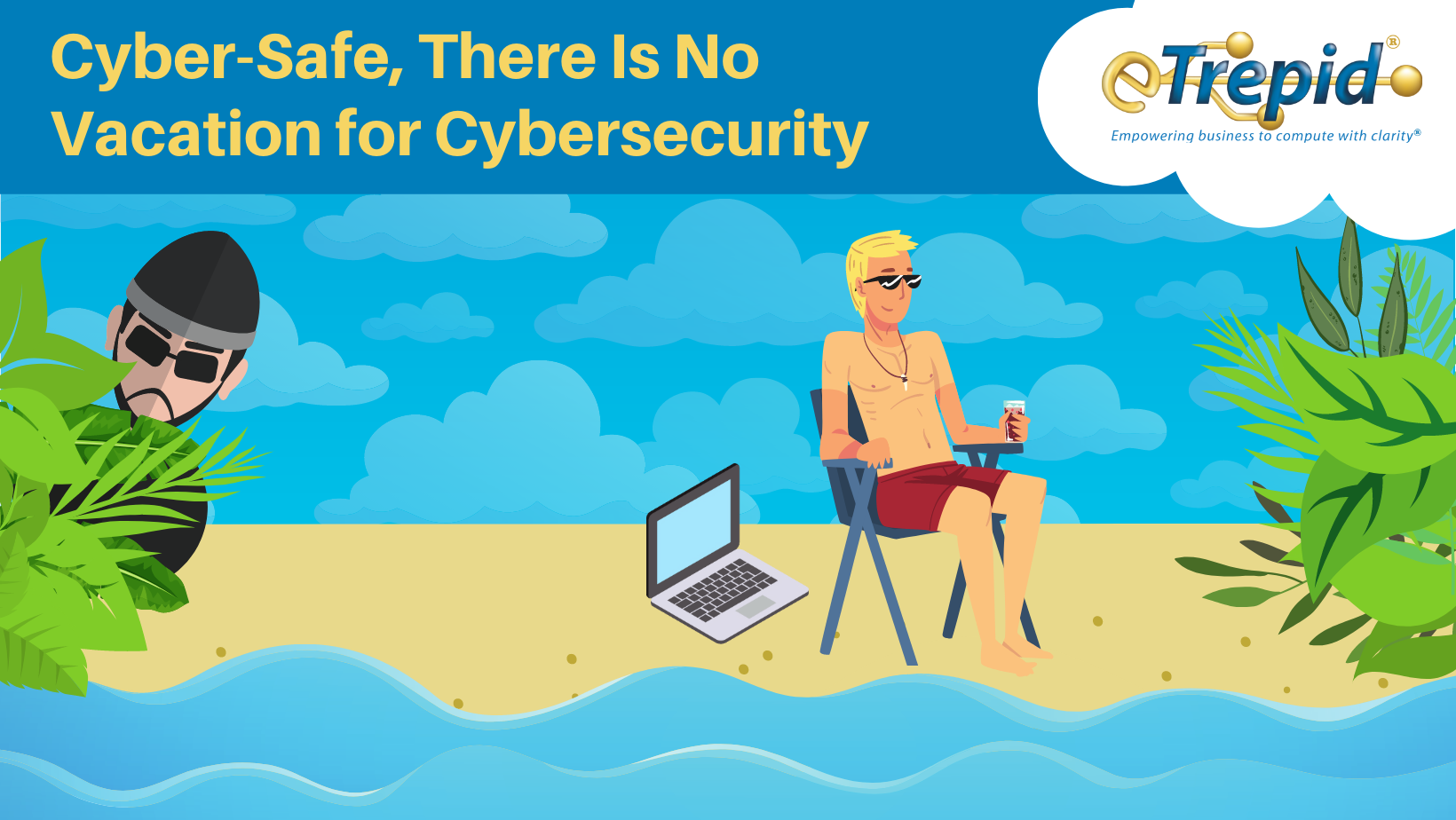Cyber-Safe, There Is No Vacation for Cybersecurity

We could all use a vacation, right? A time to relax, take it easy, let all our cares slip away – that is until we get a frantic phone call from the office, a panicky employee telling you that company systems are locked up and encrypted. To restore systems, hackers are demanding $3 million in Bitcoin for the code to unlock them. We've heard a lot about this lately!
This nightmare scenario occurs more and more frequently demonstrating a simple truth about personal and professional security. Criminals do not take vacations – they work very hard at their criminal enterprises. As long as they can continue to make money by attacking vulnerable businesses, they will do so.
As a result, organizations are forced to remain vigilant in response or risk catastrophic consequences to their operations.
Achieving Peace of Mind
It wouldn't be much of a vacation if you're constantly anxious about your company's security while you are away. Unfortunately, with more than 3,000 publicly reported cybersecurity breaches in 2020 alone, companies are at greater risk of compromise than ever before. In addition, cyber-criminals have become more sophisticated and focused, methodically researching organizations for lengthy periods to discover vulnerable access points that they can exploit.
Minimizing vulnerabilities is a fundamental part of effective cybersecurity planning, reducing the opportunity for criminals to gain access to essential business systems. To achieve the peace of mind that comes with knowing your company (and your clients) are secure, business owners need intelligent solutions that continuously work to protect organizational systems.
Intelligent solutions for maintaining cybersecurity should be multifaceted, working together on various fronts to keep a company as secure as possible. Not only should these solutions include targeted software applications for monitoring systems, backing up data, and verifying access credentials, but comprehensive cybersecurity measures should also include detailed incident response plans to guide recovery in the event that breaches occur.
The Risk of Wi-Fi Compromise
One of the biggest and often forgotten challenges to maintaining cybersecurity include the vulnerabilities associated with Wi-Fi network connections. With remote working options becoming the norm for businesses, the risk of sacrificing security for convenience is a genuine concern.
Using public Wi-Fi presents opportunities for criminal actors, who can use various methods to gain access to valuable information and critical systems. Here are just some of the ways these criminals use to take advantage of public Wi-Fi:
- Man in the Middle – MITM attacks are a particularly dangerous type of Wi-Fi compromise, where hackers will infiltrate private networks by impersonating access points to acquire login credentials. Attackers will set up hardware that imitates trusted Wi-Fi networks, often luring unsuspecting victims through the appeal of robust signal strength.
- Packet Sniffing – Packet sniffers are computer programs designed to monitor wireless network traffic, which hackers weaponize to intercept data packages. Hackers can then use intercepted data packages to introduce errors and break down network defenses.
- Malware – If a wireless network allows file sharing, hackers can use the opportunity to transmit malicious software onto a device that has connected to the network. Criminals can also compromise the connection point itself, setting up pop-up windows to appear as part of the normal network connection process. Users subsequently interacting with these pop-ups will unintentionally download malware onto their devices.
Maintaining Wi-Fi Security
While the risks associated with using Wi-Fi networks for business activities are alarming, there are proven security measures that users can rely on to help ensure they stay secure.
- Use Virtual Private Networks – VPNs are critical for users connecting to business systems from unsecured access points, like Wi-Fi hotspots. A VPN enables users to send and receive data across shared or public networks through advanced encryption as if users directly connected their devices to a private network.
- Use Transport Layer Security – TLS is a cryptographic protocol designed to provide communications security over a network. The successor to deprecated SSL protocol, TLS serves as the security layer in HTTPS, providing enhanced encryption and browser defense. Configuring browsers to default to HTTPS helps ensure safe internet use.
- Turning Off Wi-Fi When Unneeded – Even if a device isn't actively connected to a Wi-Fi network, Wi-Fi hardware still transmits data between networks within range. Turning Wi-Fi off when working on projects that do not require internet access can be an added measure of security that helps ensure compromised Wi-Fi networks are not inadvertently accessed simply by device proximity.
Application Shielding
Application shielding is another intelligent cybersecurity solution, utilizing a process that obscures an application's binary code to make it more secure. By obfuscating application codes, application shielding makes it more difficult for malicious cybercriminals to compromise digital rights locks, or otherwise infiltrate application environments.
Application shielding provides an extra layer of security, with some providers integrating biometric scanning technologies into application shields to further prevent unauthorized access and unapproved application use. Particularly useful to companies that rely on digital rights or product licenses as part of normal operations, incorporating application shields into a comprehensive cybersecurity plan can also help companies satisfy licensing agreements and regulatory requirements.
An Evolving Threat
As the threat of cyberattack becomes more prominent, industry leaders must remain flexible and vigilant. Thankfully, business owners are not alone. Even lawmakers are starting to take these threats more seriously, with bills like the Cyber Shield Act introduced in the senate.
In fact, Deputy Attorney General Lisa Monaco even publicly committed to a 4-month-long reassessment of the Department of Justice cybersecurity strategy.
Due in part because 2020 was the "worst year we have experienced to date when it comes to ransomware," Monaco estimates, with damages against companies and governments measured in the billions of dollars.
"Ransomware is one manifestation which we are now seeing in the headlines, but more broadly, what is the next ransomware that we're going to have to deal with, what is the next exploitation by bad actors of other technologies, whether it's AI, again digital currency issues, what is the next iteration of the supply chain attack that we've seen," Monaco asked.
The threat is not hyperbolic, and businesses hoping to stay secure moving forward must evaluate their strategy regularly. Part of that strategy should include managed services. Managed IT services let you relax so we can worry about protecting you today and while you're gone.
Every year, small business networks, security, and cloud infrastructure grow increasingly complex across more devices. Any number of issues can arise in a given day and it only takes one disruption to realize just how critical your data is to your bottom line.
Unfortunately, this exhaustive process makes maintaining an in-house IT team an impractical solution for many DoD contractors and small to medium-sized businesses. But there is an alternative to your own onsite IT support department.
Our wide range of technology services offered to our business government contractor clients include expert cybersecurity services with the safeguards needed to comply with NIST, DFARS, and CMMC
- NIST, DFARS, CMMC Assessments and Remediation
- Microsoft Office 365 Government Cloud
- Business Continuity/Disaster Recovery
- Multi-Factor Authentication
- Intrusion Detection and Response
- Security Awareness Training
- IT User Policies
- Security Incident Response Plan
- Advanced Endpoint Protection
eTrepid is an award-winning veteran-owned managed service provider and Managed Security Service Provider (MSSP) that assures a rapid response and resolution to virtually all business IT needs, allowing for a ten-minute response time guarantee. eTrepid also remains at the forefront of industry changes, such as regulations associated with the Cybersecurity Maturity Model Certification (CMMC).
By outsourcing your IT and partnering with eTrepid, you have more time to grow your business while keeping up with the latest proven technologies. Whether you are a defense contractor or a small- to mid-sized business, chances are your range of IT resources is holding you back.
Sign up for a consultation on managed services and find out how you can get the same level of expertise, equipment, and support as government entities and large corporations without managing the IT infrastructure it requires.




.png)
Leave A Comment